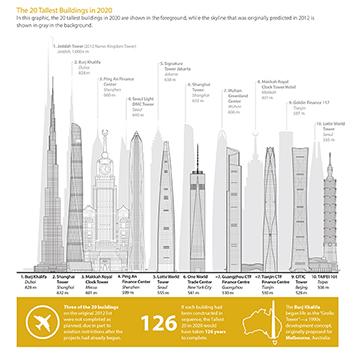Filter by
You must be a CTBUH Member to view this resource.
Suzhou IFS
The Wharf IFS, The Wharf Suzhou, Suzhou International Finance Square, Suzhou Supertower
Building
Completed, 2019
215021
hotel / office / serviced apartments
composite
450.0 m / 1,476 ft
95
5
470
224
1300
62
10 m/s
310,000 m² / 3,336,812 ft²
You must be a CTBUH Member to view this resource.
You must be a CTBUH Member to view this resource.
Usually involved in the front end design, with a "typical" condition being that of a leadership role through either Schematic Design or Design Development, and then a monitoring role through the CD and CA phases.
Usually takes on the balance of the architectural effort not executed by the "Design Architect," typically responsible for the construction documents, conforming to local codes, etc. May often be referred to as "Executive," "Associate," or "Local" Architect, however, for consistency CTBUH uses the term "Architect of Record" exclusively.
The Design Engineer is usually involved in the front end design, typically taking the leadership role in the Schematic Design and Design Development, and then a monitoring role through the CD and CA phases.
The Engineer of Record takes the balance of the engineering effort not executed by the “Design Engineer,” typically responsible for construction documents, conforming to local codes, etc.
Other Consultant refers to other organizations which provided significant consultation services for a building project (e.g. wind consultants, environmental consultants, fire and life safety consultants, etc).
These are firms that consult on the design of a building's façade. May often be referred to as "Cladding," "Envelope," "Exterior Wall," or "Curtain Wall" Consultant, however, for consistency CTBUH uses the term "Façade Consultant" exclusively.
Material Supplier refers to organizations which supplied significant systems/materials for a building project (e.g. elevator suppliers, facade suppliers, etc).
You must be a CTBUH Member to view this resource.
Usually involved in the front end design, with a "typical" condition being that of a leadership role through either Schematic Design or Design Development, and then a monitoring role through the CD and CA phases.
Usually takes on the balance of the architectural effort not executed by the "Design Architect," typically responsible for the construction documents, conforming to local codes, etc. May often be referred to as "Executive," "Associate," or "Local" Architect, however, for consistency CTBUH uses the term "Architect of Record" exclusively.
The Design Engineer is usually involved in the front end design, typically taking the leadership role in the Schematic Design and Design Development, and then a monitoring role through the CD and CA phases.
The Design Engineer is usually involved in the front end design, typically taking the leadership role in the Schematic Design and Design Development, and then a monitoring role through the CD and CA phases.
The Engineer of Record takes the balance of the engineering effort not executed by the “Design Engineer,” typically responsible for construction documents, conforming to local codes, etc.
The CTBUH lists a project manager when a specific firm has been commissioned to oversee this aspect of a tall building’s design/construction. When the project management efforts are handled by the developer, main contract, or architect, this field will be omitted.
The main contractor is the supervisory contractor of all construction work on a project, management of sub-contractors and vendors, etc. May be referred to as "Construction Manager," however, for consistency CTBUH uses the term "Main Contractor" exclusively.
Other Consultant refers to other organizations which provided significant consultation services for a building project (e.g. wind consultants, environmental consultants, fire and life safety consultants, etc).
These are firms that consult on the design of a building's façade. May often be referred to as "Cladding," "Envelope," "Exterior Wall," or "Curtain Wall" Consultant, however, for consistency CTBUH uses the term "Façade Consultant" exclusively.
Material Supplier refers to organizations which supplied significant systems/materials for a building project (e.g. elevator suppliers, facade suppliers, etc).
Best Tall Building 400 meters and above 2021 Award of Excellence
2021 CTBUH Awards
CTBUH Study Examines Tallest Buildings with Dampers
22 August 2018 - CTBUH Research
CTBUH Signboard Unveiled at Suzhou IFS
20 June 2018 - Event

17 September 2014 | Suzhou
Design Challenges of the 3 Tallest Buildings in North/ East/ South China
This presentation describes the MEP and VTS design challenges of the tallest buildings in three major cities in China; namely, Beijing, Suzhou and Guangzhou. The...

20 March 2020
Tall + Urban Innovation 2020: Dominant Trends
CTBUH Research
Providing a global overview of tall building development, design and construction, the CTBUH Awards Program and related Tall + Urban Innovation Conference annually survey projects,...
Suzhou IFS aims to be a landmark on the city’s skyline in both form and function, drawing upon modern design practices to belay the area’s historical repertoire. Conceived as a mixed-use high-rise, the tower will incorporate a number of disparate programs, embodying a modern 21st century presence that is symbolically tied to the city’s identity.
Suzhou has long been a center of trade in China, and the building’s design pays tribute to this achievement. The tower’s form is reminiscent of a fish, a symbol of prosperity and a nod to the role that water has played in the city’s history and identity—the city is surrounded by lakes and canals, causing it to become known as “Venice of the East.” As such, the tower is designed to interact with the surrounding bodies of water. The tower gestures towards Jinji Lake and opens out towards the water.
Soaring upwards, the curved “tail” of the fish subtly transitions from the scale of the lake and surrounding buildings to the top of the tower. More than an architectural embellishment, the flared base maximizes views of the water for the serviced apartments within and considerably lengthens its street frontage. At night, the tower cladding is articulated with glowing LEDs. These lights activate in a staggered timing that causes the building to shimmer in the evening skyline, much like the nearby lake.
The tower form and orientation, together with the articulation of the west façade, diminishes much of the heat and glare, while bringing more natural daylight to the internal spaces. The tower cladding is a high-performance glazing that significantly mitigates solar loading.
Best Tall Building 400 meters and above 2021 Award of Excellence
2021 CTBUH Awards

20 March 2020
Tall + Urban Innovation 2020: Dominant Trends
Providing a global overview of tall building development, design and construction, the CTBUH Awards Program and related Tall + Urban Innovation Conference annually survey projects,...

20 March 2020
The Tallest 20 in 2020: Predictions vs. Reality
In the first edition of the 2012 Journal, CTBUH published a Tall Buildings in Numbers study titled Tallest 20 in 2020: Era of the Megatall—The...

01 September 2015
The New Structural Design Process of Supertall Buildings in China
By the end of 2014, the number of completed and under-construction supertall buildings above 250 meters in China reached 90 and 129, respectively. China has...

16 September 2014
Design Challenges of the 3 Tallest Buildings in North/ East/ South China
This paper describes the MEP and VTS design challenges of the tallest buildings in three major cities in China; namely, Beijing, Suzhou and Guangzhou. The...
22 August 2018
CTBUH has released a Tall Buildings in Numbers (TBIN) interactive data study on the world's tallest buildings with dampers.
20 June 2018
Suzhou IFS recently installed a CTBUH Signboard, recognizing the building as the eighth tallest building in mainland China and the tallest building in the Jiangsu province.
Subscribe below to receive periodic updates from CTBUH on the latest Tall Building and Urban news and CTBUH initiatives, including our monthly newsletter. Fields with a red asterisk (*) next to them are required.
View our privacy policy